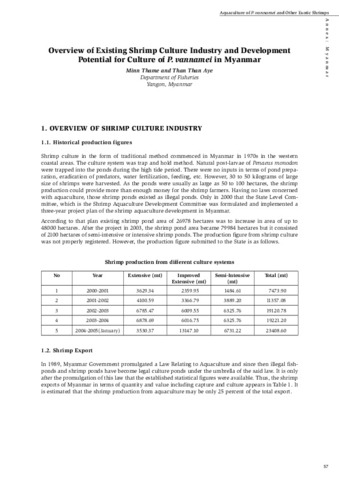Overview of existing shrimp culture industry and development potential for culture of P. vannamei in Myanmar.
- Global styles
- MLA
- Vancouver
- Elsevier - Harvard
- APA
- Help
Share
นามธรรม
Shrimp culture in the form of traditional method commenced in Myanmar in 1970s in the western coastal areas. The culture system was trap and hold method. Natural post-larvae of Penaeus monodon were trapped into the ponds during the high tide period. There were no inputs in terms of pond preparation, eradication of predators, water fertilization, feeding, etc. However, 30 to 50 kilograms of large size of shrimps were harvested. As the ponds were usually as large as 50 to 100 hectares, the shrimp production could provide more than enough money for the shrimp farmers. Having no laws concerned with aquaculture, those shrimp ponds existed as illegal ponds. Only in 2000 that the State Level Committee, which is the Shrimp Aquaculture Development Committee was formulated and implemented a three-year project plan of the shrimp aquaculture development in Myanmar.
According to that plan existing shrimp pond area of 26978 hectares was to increase in area of up to 48000 hectares. After the project in 2003, the shrimp pond area became 79984 hectares but it consisted of 2100 hectares of semi-intensive or intensive shrimp ponds. The production figure from shrimp culture was not properly registered.
การอ้างอิง
Thame, M. & Aye, T.T. (2005). Overview of existing shrimp culture industry and development potential for culture of P. vannamei in Myanmar. In: Regional Technical Consultation on the Aquaculture of P. vannamei and Other Exotic Shrimps in Southeast Asia, Manila, Philippines (pp. 57-61). Tigbauan, Iloilo, Philippines : SEAFDEC Aquaculture Department.
Type
Meeting report


